ASUS VivoBook S14 S435 review – a ZenBook in disguise
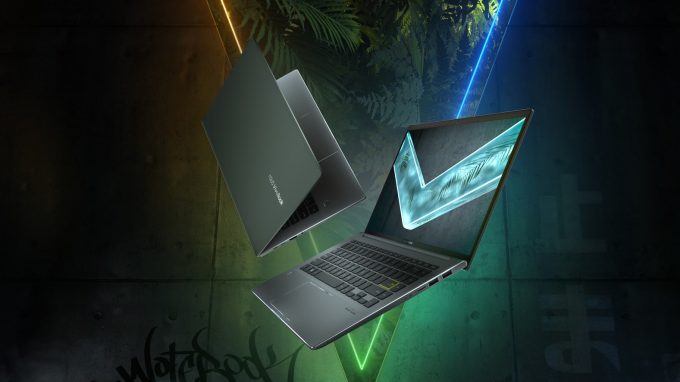 If you are planning to buy a notebook, there are a couple of questions you need to answer before you make a decision. First, what do you need your laptop for? Are you going to play games on it, use it as a workhorse, or just for multimedia consumption? Then, you need to figure out your budget.
If you are planning to buy a notebook, there are a couple of questions you need to answer before you make a decision. First, what do you need your laptop for? Are you going to play games on it, use it as a workhorse, or just for multimedia consumption? Then, you need to figure out your budget.
So, if you are in school, work from home, or just want to express yourself, one of the best options is the VivoBook series. And if you are planning to invest a bit more – the ZenBook, also from ASUS. However, if your budget is tight, but you still want something of good quality, then the ASUS VivoBook S-series fall right into your target group of devices.
Even though the VivoBook was always about compromises, this year, ASUS has other plans. Introducing, the VivoBook S14 S435 with all-metal chassis, and Tiger Lake CPUs. In addition to that, the laptop is part of the Evo platform, which ensures high performance and good efficiency.
Not in the last place, the manufacturer is promising that the 14-inch display will cover 100% of the sRGB color gamut, and will have 400 nits of brightness. Not bad at all, provided these claims are accurate.
You can check the prices and configurations in our Specs System: https://laptopmedia.com/series/asus-vivobook-s14-s435/
Contents
Specs Sheet
- Visualizza
- 14.0”, Full HD (1920 x 1080), IPS
- HDD/SSD
- fino a 1000GB SSD
- Slot M.2
- 1x M.2 NVMe slot Vedi foto
- RAM
- up to 16GB
- OS
- Windows 10 Home, Windows 10 Pro
- Batteria
- 67Wh, 4-cell
- Materiale del corpo
- Aluminum
- Dimensioni
- 322.2.x 204 x 15.9 mm (12.69" x 8.03" x 0.63")
- Peso
- 1.30 kg (2.9 lbs)
- Porte e connettività
- 1x USB Type-A
- 2.0
- 1x USB Type-A
- 3.2 Gen 1 (5 Gbps)
- 2x USB Type-C
- Thunderbolt 4
- HDMI
- Lettore di schede
- MicroSD
- Wi-Fi
- 802.11ax
- Bluetooth
- 5.0
- Jack audio
- 3.5mm Combo Jack
- Caratteristiche
- Lettore di impronte digitali
- Telecamera web
- HD
- Tastiera retroilluminata
- Microfono
- Array microphone with Cortana voice-recognition support
- Altoparlanti
- Unità ottica
Tutti ASUS VivoBook S14 (S435) configurazioni
What’s in the box?
Inside this notebook’s packaging, you will find some paper manuals, a 65W USB Type-C power brick, as well as a cool bag.
Design and construction
For the first time, we see a VivoBook with an all-metal design. That’s right, the VivoBook S14 S435 is made out of aluminum, with “diamond cut” chamfered edges. It looks and feels really solid, thus appearing like a ZenBook in disguise. Thankfully, the laptop is both thin and light, as it measures 15.9mm in profile and weighs only 1.30 kg. After all, the competition has gone far, so ASUS had to step up their game.
Interestingly, even the lid opens with a single hand, as the hinges feel smooth up until the 90-100° mark. Here, the display has a matte finish and is surrounded by pretty slim bezels, for an alleged screen-to-body ratio of 90%. Additionally, you can see an HD Web camera – a feature that has become somewhat mandatory in the past year.
As we said, the laptop is structurally sound, although there is a very slight observable flex, when we twist the notebook. As far as the keyboard goes, we can confidently say, that it is comfortable to use. This is thanks to the decent key travel and the clicky feedback. Also, it has a backlight. If you look closely, you will see the signature Enter key that has a yellow accent around it. Here, the only disadvantage we found was the size of the Arrow keys.
Moving to the touchpad, we get a glass-covered surface, which delivers a decent gliding experience. Its tracking is great, and the clicking mechanism is on point. In fact, it registers a click in pretty much every point of the surface. By the way, this device also supports ASUS’s NumberPad. It can be enabled by holding your finger on the top right corner for 1 second. Respectively, the shortcut on the top left corner launches the Calculator app by swiping and toggles between two brightness settings when held. By the way, there is a fingerprint reader, as well, and it is located on the left part of the palm rest area.
If you turn the laptop upside down, you will notice the speaker cutouts. Interestingly, the tiny ventilation grill is placed in the opposite corner to the fan, while the hot air is pushed away from a grill in between the lid and the base. Actually, we are pretty confident that the fan draws some of the air through the keyboard, but the rest is sucked from the vent on the bottom panel. This takes some of the heat away from the VRM modules, and the SSD, which is good. On the other hand, this means that warmer air enters the fan, hindering the overall cooling capacity. Nevertheless, we will see the efficiency of this setup in the “Temperatures and comfort” portion of this review.
Ports
On the left side, you will find two Thunderbolt 4 connectors, an HDMI 1.4 connector, and an audio jack. Switch the laptop around, and you’ll see a USB Type-A 3.2 (Gen. 1) port, a USB Type-A 2.0 port, and a MicroSD card slot.
Disassembly, upgrade options and maintenance
This laptop’s bottom panel is held in place by 9 Torx-head screws. After you undo them, you need to pry the panel with a plastic tool. Then, lift it away from the chassis.
It’s good to see that ASUS has integrated a 67Wh battery pack inside of this machine.
Sadly, but expectedly, the memory is soldered to the motherboard. However, the configurations available include 8 and 16GB of LPDDR4x RAM. Thankfully, the storage can be upgraded via one M.2 PCIe x4 slot.
Now, the cooling solution looks pretty typical for a laptop of this class. It has a pretty beefy heat pipe, a heat sink, and a fan, which has a rather slim profile. However, ASUS state that their fan blades have a 3D-curved design, whatever this means.
Display quality
ASUS VivoBook S14 S435’s main display has a touchscreen Full HD panel, model number AUO B140HAN06.B (AUOA48F). Its diagonal is 14″ (35.56 cm), and the resolution – 1920 х 1080. Additionally, the screen ratio is 16:9, the pixel density – 157 ppi, their pitch – 0.161 x 0.161 mm. The screen can be considered Retina when viewed from at least 55 cm (from this distance, the average human eye can’t see the individual pixels).
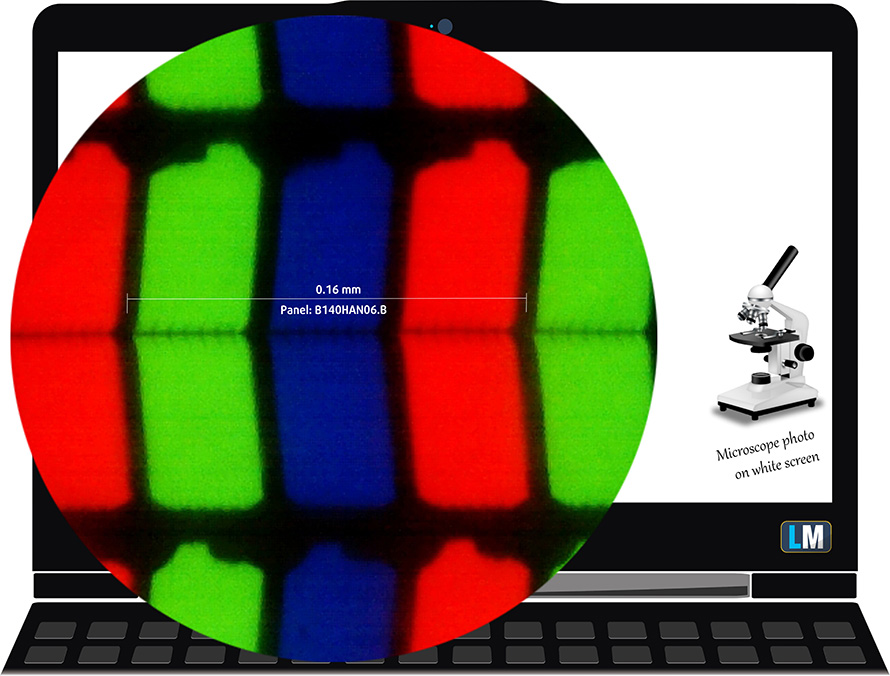
It has comfortable viewing angles. We have provided images at 45 degrees to evaluate quality.

The maximum measured brightness is 380 nits (cd/m2) in the middle of the screen and 384 nits (cd/m2) average across the surface with a maximum deviation of 9%. The Correlated Color Temperature on a white screen and at maximum brightness is 6520K (average) – matching the 6500K optimum for sRGB.
In the illustration below you can see how the display performs from a uniformity perspective.
Values of dE2000 over 4.0 should not occur, and this parameter is one of the first you should check if you intend to use the laptop for color-sensitive work (a maximum tolerance of 2.0 ). The contrast ratio is very good – 1590:1.
To make sure we are on the same page, we would like to give you a little introduction to the sRGB color gamut and the Adobe RGB. To start, there’s the CIE 1976 Uniform Chromaticity Diagram that represents the visible specter of colors by the human eye, giving you a better perception of the color gamut coverage and the color accuracy.
Inside the black triangle, you will see the standard color gamut (sRGB) that is being used by millions of people on HDTV and on the web. As for the Adobe RGB, this is used in professional cameras, monitors, etc for printing. Colors inside the black triangle are used by everyone and this is the essential part of the color quality and color accuracy of a mainstream notebook.
Still, we’ve included other color spaces like the famous DCI-P3 standard used by movie studios, as well as the digital UHD Rec.2020 standard. Rec.2020, however, is still a thing of the future and it’s difficult for today’s displays to cover that well. We’ve also included the so-called Michael Pointer gamut, or Pointer’s gamut, which represents the colors that naturally occur around us every day.
The yellow dotted line shows ASUS VivoBook S14 S435’s color gamut coverage.
Its display covers 98% of the sRGB/ITU-R BT.709 (web/HDTV standard) in CIE1976.
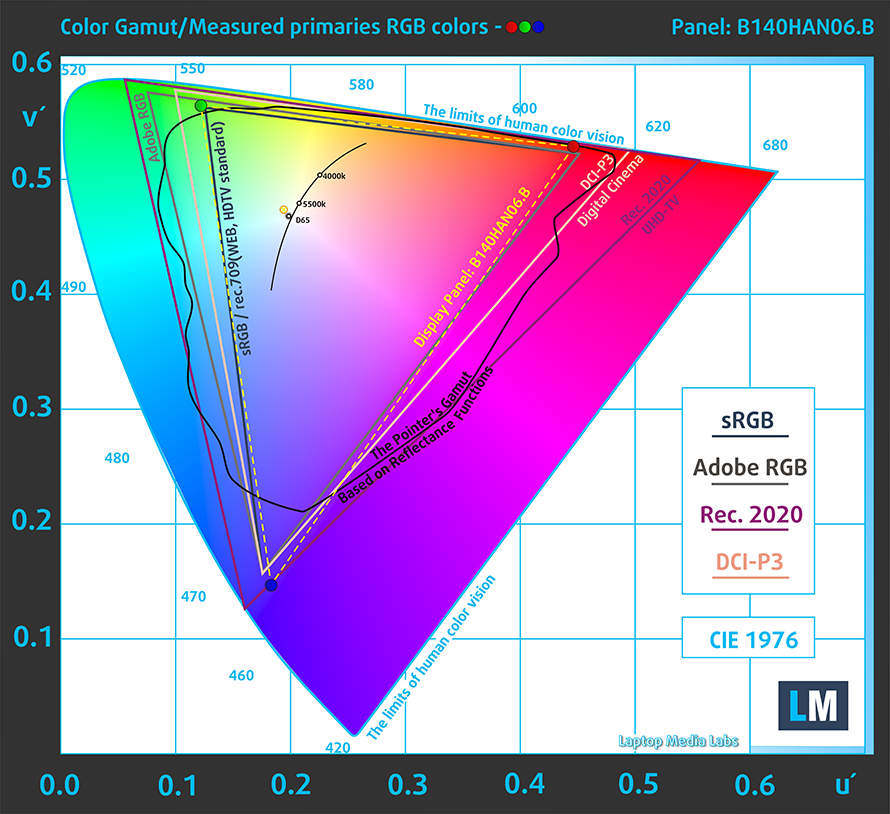
Our “Design and Gaming” profile delivers optimal color temperature (6500K) at 140 cd/m2 luminance and sRGB gamma mode.
We tested the accuracy of the display with 24 commonly used colors like light and dark human skin, blue sky, green grass, orange, etc. You can check out the results at factory condition and also, with the “Design and Gaming” profile.
Below you can compare the scores of ASUS VivoBook S14 S435 with the default settings (left), and with the “Gaming and Web design” profile (right).
The next figure shows how well the display can reproduce dark parts of an image, which is essential when watching movies or playing games in low ambient light.
The left side of the image represents the display with stock settings, while the right one is with the “Gaming and Web Design” profile activated. On the horizontal axis, you will find the grayscale, and on the vertical axis – the luminance of the display. On the two graphs below you can easily check for yourself how your display handles the darkest nuances but keep in mind that this also depends on the settings of your current display, the calibration, the viewing angle, and the surrounding light conditions.

Response time (Gaming capabilities)
We test the reaction time of the pixels with the usual “black-to-white” and “white-to-black” method from 10% to 90% and vice versa.
We recorded Fall Time + Rise Time = 31 ms
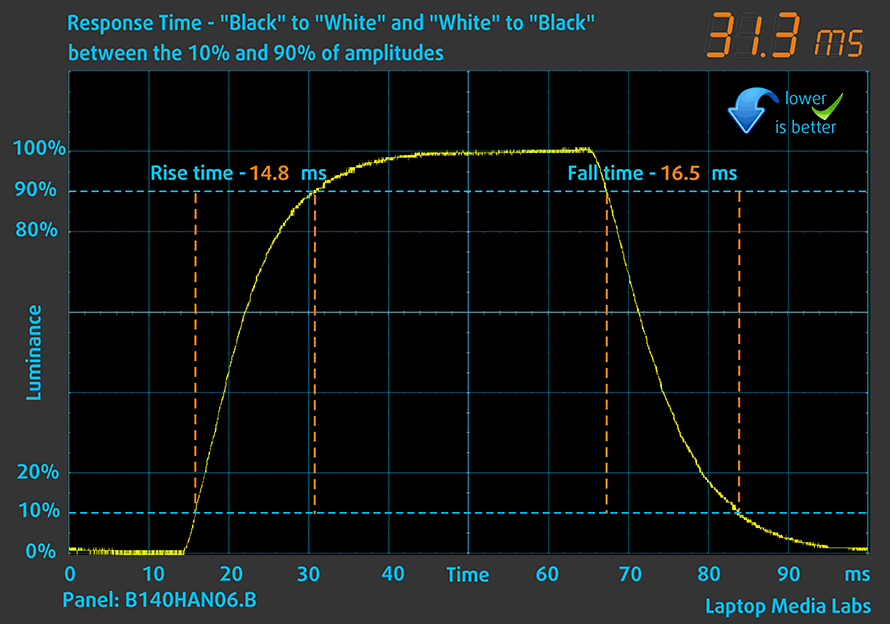
After that, we test the reaction time of the pixels with the usual “Gray-to-Gray” method from 50% White to 80% White and vice versa between 10% and 90% of the amplitude.
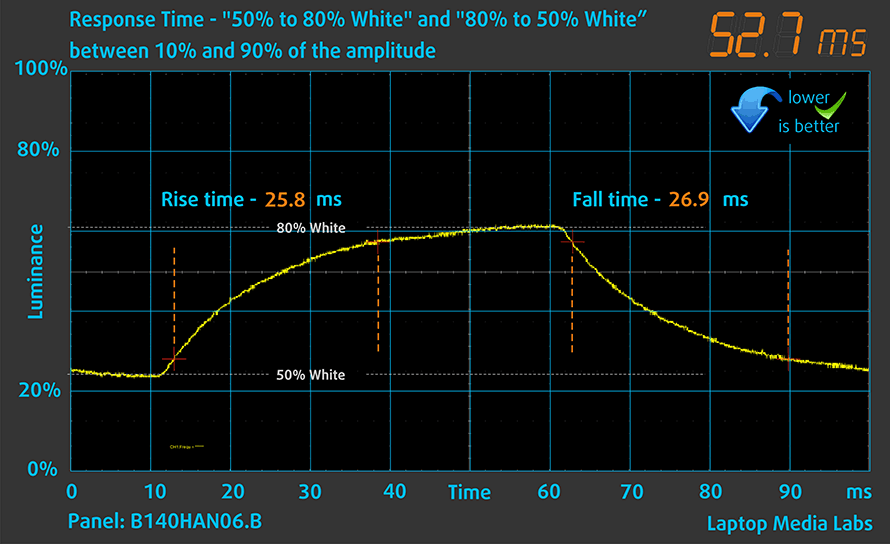
Health impact – PWM / Blue Light
PWM (Screen flickering)
Pulse-width modulation (PWM) is an easy way to control monitor brightness. When you lower the brightness, the light intensity of the backlight is not lowered, but instead turned off and on by the electronics with a frequency indistinguishable to the human eye. In these light impulses, the light/no-light time ratio varies, while brightness remains unchanged, which is harmful to your eyes. You can read more about that in our dedicated article on PWM.
The light coming from ASUS VivoBook S14 S435’s backlight does not flicker. This makes it comfortable for use during long periods, without harming your eyes in this aspect.
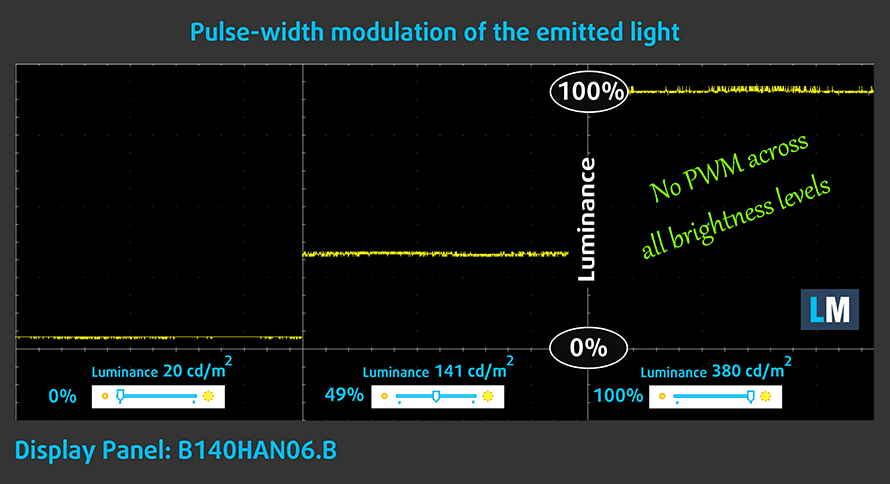
Blue light emissions
Installing our Health-Guard profile not only eliminates PWM but also reduces the harmful Blue Light emissions while keeping the colors of the screen perceptually accurate. If you’re not familiar with the Blue light, the TL;DR version is – emissions that negatively affect your eyes, skin, and your whole body. You can find more information about that in our dedicated article on Blue Light.
Conclusions
ASUS VivoBook S14 S435’s IPS panel has a Full HD resolution, decent maximum brightness, a very good contrast ratio, and comfortable viewing angles. This particular panel, which is the same as that of the ASUS ZenBook Duo 14 UX482, covers 98% of the sRGB gamut. It doesn’t use PWM and can be used for professional work. Especially with our Gaming and Web design profile, which delivers standard-matching color accuracy.
Buy our profiles
Since our profiles are tailored for each display model, this article and its respective profile package are meant for ASUS VivoBook S14 S435 configurations with 14.0″ AUO B140HAN06.B (AUOA48F) (FHD, 1920 × 1080) IPS panel.
*Should you have problems with downloading the purchased file, try using a different browser to open the link you’ll receive via e-mail. If the download target is a .php file instead of an archive, change the file extension to .zip or contact us at [email protected].
Read more about the profiles HERE.
Oltre a ricevere profili efficienti e rispettosi della salute, comprando i prodotti di LaptopMedia sostenete anche lo sviluppo dei nostri laboratori, dove testiamo i dispositivi per produrre le recensioni più obiettive possibili.

Lavoro in ufficio
Lavoro in ufficio dovrebbe essere usato soprattutto dagli utenti che passano la maggior parte del tempo a guardare pezzi di testo, tabelle o semplicemente a navigare. Questo profilo mira a fornire una migliore distinzione e chiarezza mantenendo una curva gamma piatta (2.20), una temperatura di colore nativa e colori percettivamente accurati.

Design e gioco
Questo profilo è rivolto ai designer che lavorano professionalmente con i colori, e anche per giochi e film. Design and Gaming porta i pannelli di visualizzazione ai loro limiti, rendendoli il più accurati possibile nello standard sRGB IEC61966-2-1 per Web e HDTV, al punto di bianco D65.

Salute-Guardia
Salute-Guardia elimina la nociva Pulse-Width Modulation (PWM) e riduce la luce blu negativa che colpisce i nostri occhi e il nostro corpo. Essendo personalizzato per ogni pannello, riesce a mantenere i colori percettivamente accurati. Salute-Guardia simula la carta, quindi la pressione sugli occhi è notevolmente ridotta.
Ottenete tutti e 3 i profili con il 33% di sconto
Sound
ASUS VivoBook S14 S435’s speakers are tuned by Harman Kardon. They produce a sound with very good quality, as its low, mid, and high tones are clear of deviations.
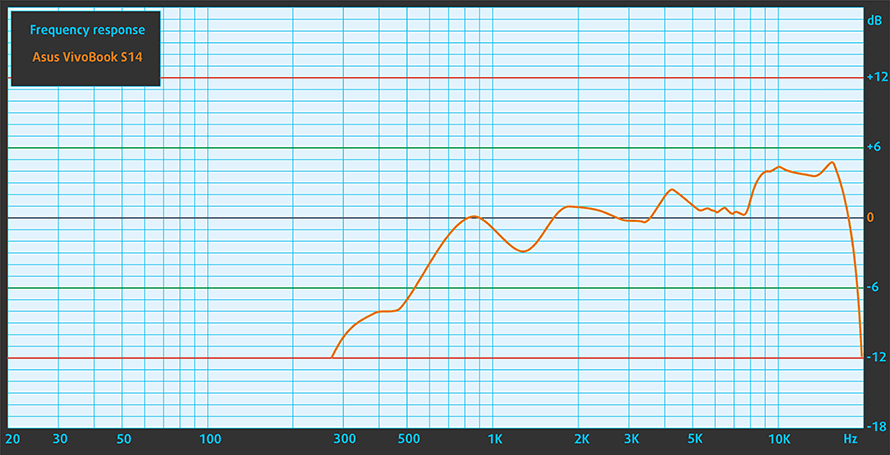
Drivers
All of the drivers and utilities can be downloaded from here: https://www.asus.com/Laptops/For-Home/VivoBook/VivoBook-S14-S435/HelpDesk_Download/?model2Name=VivoBook-S14-S435
Battery
Now, we conduct the battery tests with Windows Better performance setting turned on, screen brightness adjusted to 120 nits, and all other programs turned off except for the one we are testing the notebook with. Here, the 67Wh battery delivers 13 hours and 20 minutes of Web browsing, and 14 hours and 10 minutes of video playback.
Per simulare le condizioni reali, abbiamo utilizzato un nostro script per la navigazione automatica su oltre 70 siti web.
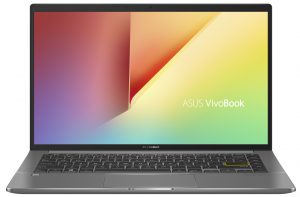
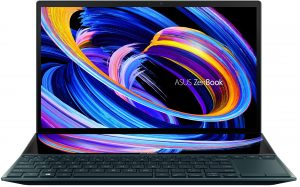
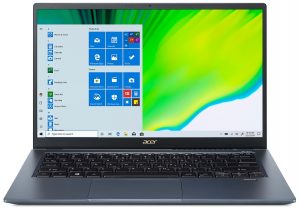
Per ogni test come questo, utilizziamo lo stesso video in HD.



CPU options
There are two configurations, depending on the processor. They come with either the Core i5-1135G7 or the Core i7-1165G7.
I risultati provengono dal test CPU Cinebench 20 (più alto è il punteggio, meglio è)
I risultati provengono dal nostro test di Photoshop (più basso è il punteggio, meglio è)
GPU options
Respectively, the only graphics option is the integrated Iris Xe Graphics G7 with either 80 or 96 EUs. Given its potential, though, you shouldn’t be disappointed.
I risultati provengono dal benchmark 3DMark: Time Spy (Graphics) (più alto è il punteggio, migliore è il risultato).
I risultati provengono dal benchmark 3DMark: Fire Strike (Grafica) (più alto è il punteggio, meglio è)
I risultati provengono dal benchmark Unigine Superposition (più alto è il punteggio, migliore è il risultato)
Gaming tests

| CS:GO | HD 1080p, Low (Check settings) | HD 1080p, Medium (Check settings) | HD 1080p, MAX (Check settings) |
|---|---|---|---|
| Average FPS | 182 fps | 129 fps | 78 fps |

| DOTA 2 | HD 1080p, Low (Check settings) | HD 1080p, Normal (Check settings) | HD 1080p, High (Check settings) |
|---|---|---|---|
| Average FPS | 133 fps | 86 fps | 64 fps |
Temperatures and comfort
Max CPU load
In this test we use 100% on the CPU cores, monitoring their frequencies and chip temperature. The first column shows a computer’s reaction to a short load (2-10 seconds), the second column simulates a serious task (between 15 and 30 seconds), and the third column is a good indicator of how good the laptop is for long loads such as video rendering.
Average core frequency (base frequency + X); CPU temp.
| Intel Core i7-1165G7 (15W TDP) | 0:02 – 0:10 sec | 0:15 – 0:30 sec | 10:00 – 15:00 min |
|---|---|---|---|
| ASUS VivoBook S14 S435 | 3.06 GHz (B+9%) @ 83°C @ 35W | 2.80 GHz @ 91°C @ 30W | 2.10 GHz @ 91°C @ 21W |
| Dell Latitude 14 5420 | 3.80 GHz (B+36%) @ 98°C @ 51W | 3.27 GHz (B+17%) @ 98°C @ 35W | 2.78 GHz @ 96°C @ 26W |
| HP EliteBook x360 1030 G8 | 3.08 GHz (B+10%) @ 98°C @ 31W | 2.77 GHz @ 98°C @ 26W | 2.35 GHz @ 85°C @ 19W |
| HP EliteBook x360 1040 G8 | 3.43 GHz (B+23%) @ 98°C @ 40W | 2.84 GHz (B+1%) @ 88°C @ 27W | 2.43 GHz @ 69°C @ 17W |
| HP Elite Dragonfly G2 | 3.17 GHz (B+13%) @ 98°C @ 34W | 2.34 GHz @ 76°C @ 18W | 2.14 GHz @ 73°C @ 16W |
| Lenovo Yoga Slim 7i Pro (14) | 3.90 GHz (B+39%) @ 85°C @ 61W | 2.57 GHz @ 69°C @ 26W | 2.37 GHz @ 57°C @ 20W |
| HP Pavilion 14 (14-dv0000) | 3.08 GHz (B+10%) @ 91°C @ 40W | 2.79 GHz @ 89°C @ 29W | 2.13 GHz @ 71°C @ 18W |
| Acer TravelMate P4 (TMP414-51) | 2.99 GHz (B+7%) @ 94°C @ 33W | 2.66 GHz @ 93°C @ 27W | 1.86 GHz @ 68°C @ 16W |
| Dell Inspiron 13 7306 2-in-1 | 3.12 GHz (B+11%) @ 99°C @ 33W | 2.68 GHz @ 99°C @ 25W | 2.04 GHz @ 83°C @ 16W |
| ASUS ZenBook Flip S UX371 | 3.48 GHz (B+24%) @ 90°C @ 43W | 2.79 GHz @ 90°C @ 27W | 1.95 GHz @ 69°C @ 14W |
| Acer Swift 3X (SF314-510G) | 3.74 GHz (B+34%) @ 95°C @ 45W | 3.45 GHz (B+23%) @ 95°C @ 37W | 3.09 GHz (B+10%) @ 85°C @ 28W |
| Acer Swift 3 (SF313-53) | 3.55 GHz (B+27%) @ 95°C @ 44W | 3.17 GHz (B+13%) @ 95°C @ 34W | 2.32 GHz @ 64°C @ 17W |
For some reason, the Performance preset didn’t really work with Prime95. In situations where the fan was blowing its life out in Cinebench R20, it was almost silent in Prime95 stress-testing. Still, with the fan barely spinning, it managed to maintain 20W and a frequency of about 2.00 GHz at the end of the test.
Comfort during full load
Because of the low fan RPM, we monitored high external temperatures, going at about 47°C.
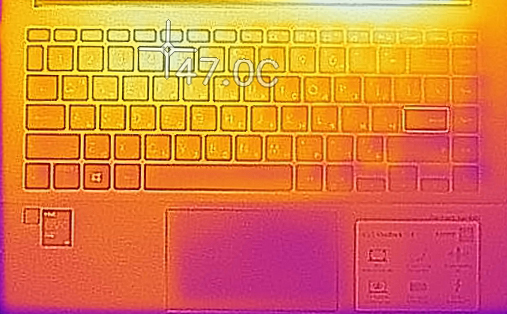
Verdict
 Before we started this review, we were not really sure what to compare it with. Given the fact that the VivoBook brand was not really known for its high-quality builds, nor its supreme battery life, we expected to see a budget all-rounder intended mainly for multimedia consumption and school work. However, once we have taken it into our hands, our perception of the S14 S435 changed dramatically.
Before we started this review, we were not really sure what to compare it with. Given the fact that the VivoBook brand was not really known for its high-quality builds, nor its supreme battery life, we expected to see a budget all-rounder intended mainly for multimedia consumption and school work. However, once we have taken it into our hands, our perception of the S14 S435 changed dramatically.
Not only did it look and feel premium, but it scored well in pretty much all of our tests. This includes the performance, where it was more than decent. After all, ASUS claims that their laptop can maintain the higher (28W) TDP limit of the processor inside. Although it was a bit less, we were happy with the stability of the performance, as every run of the Cinebench R20 benchmark produced the same results (plus or minus).
Also, ASUS VivoBook S14 S435’s IPS panel (AUO B140HAN06.B (AUOA48F)) has a Full HD resolution, decent maximum brightness, a very good contrast ratio, and comfortable viewing angles. This particular panel, which is the same as that of the ASUS ZenBook Duo 14 UX482, covers 98% of the sRGB gamut. It doesn’t use PWM and can be used for professional work. Especially with our Gaming and Web design profile, which delivers standard-matching color accuracy.
This means that a VivoBook can be used for professional work. By professionals. Can you imagine? This puts it as a possible alternative to the MacBook Air (M1, late 2020). Even the battery life was good – 13 hours and 20 minutes of Web browsing, and 14 hours and 10 minutes of video playback.
Yes, we know how absurd it is to compare it to a MacBook but there is an area where it actually beats it – the I/O. In addition to the two Thunderbolt 4 connectors, you get an HDMI connector, two USB Type-A ports (although one only reaches 2.0 speeds), and a MicroSD card slot. Also, the presence of Wi-Fi 6 means you can reach Ethernet speeds, provided you have an appropriate router.
On the other side, the soldered memory might be a bit of an issue in the long run, especially if you opt for the 8GB version of the device. But considering the competition, and the lack of memory upgradability of pretty much all ultrabooks out there (something that we don’t endorse), the VivoBook S14 S435 is easy to recommend.
You can check the prices and configurations in our Specs System: https://laptopmedia.com/series/asus-vivobook-s14-s435/
Pros
- 2x Thunderbolt 4, MicroSD card slot
- Up to 64 GB of RAM in dual-channel
- Fingerprint reader
- Wi-Fi 6, PCIe x4
- 98% sRGB coverage and Average dE of 1.1 with our Gaming and Web design profile (AUO B140HAN06.B (AUOA48F))
- No PWM (AUO B140HAN06.B (AUOA48F))
- Comfortable keyboard with a backlight
- Good battery life
- All-aluminum build
Cons
- Soldered memory
- Small arrow keys
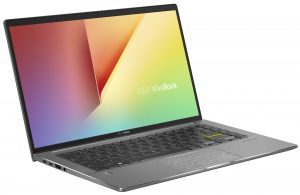
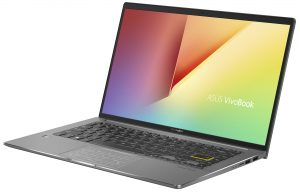
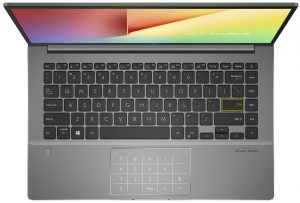
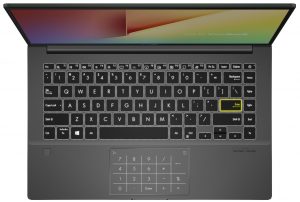
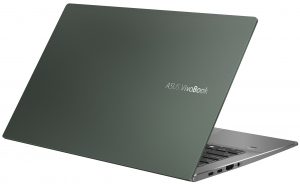
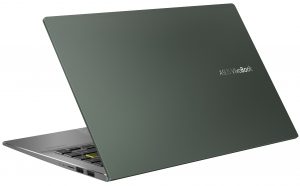
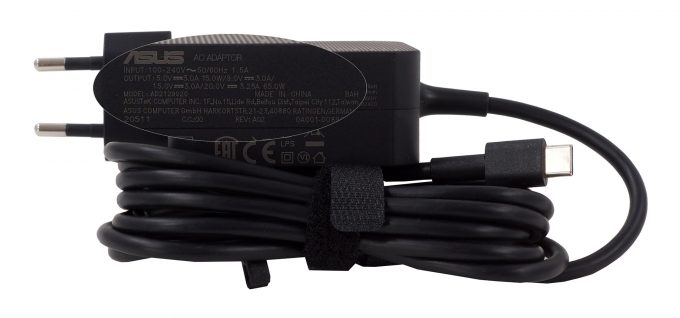
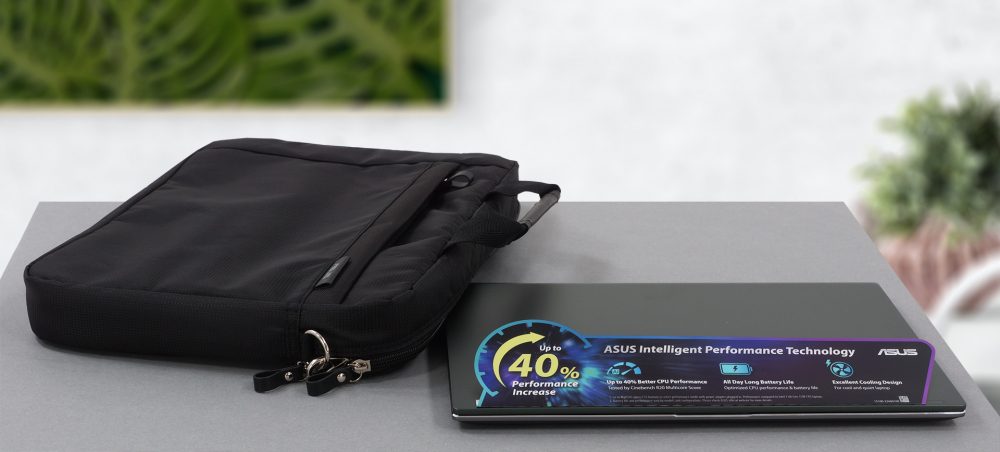
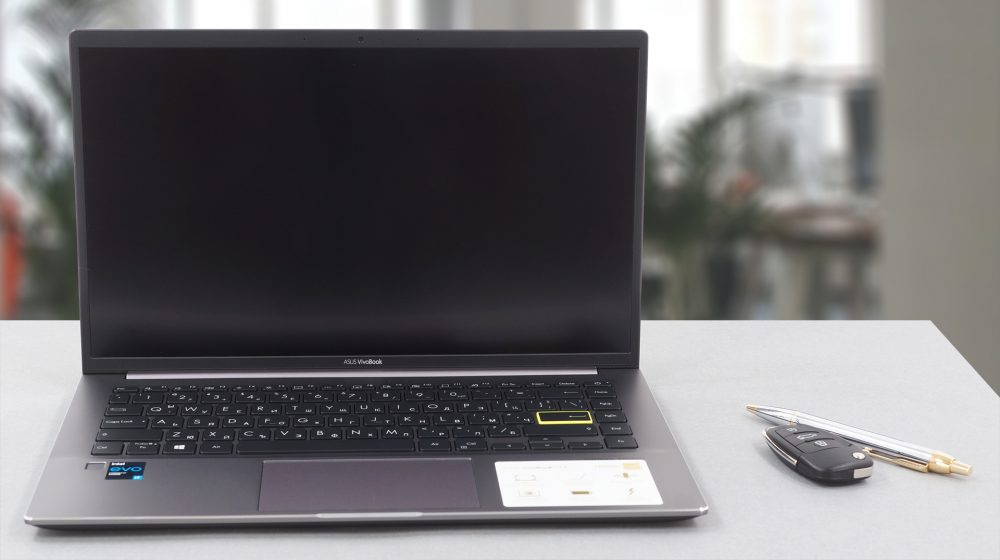
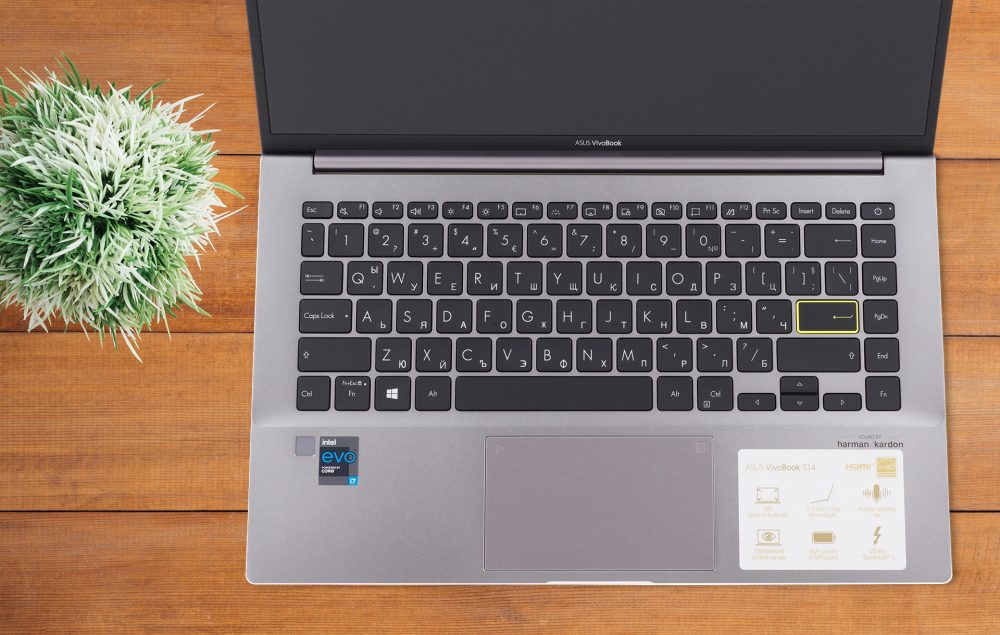
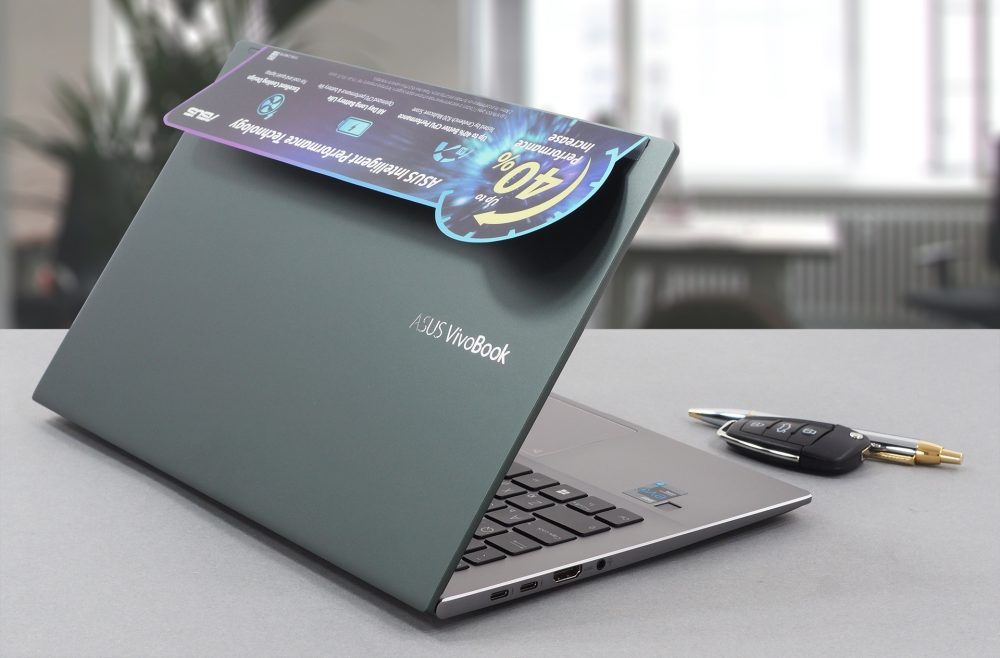

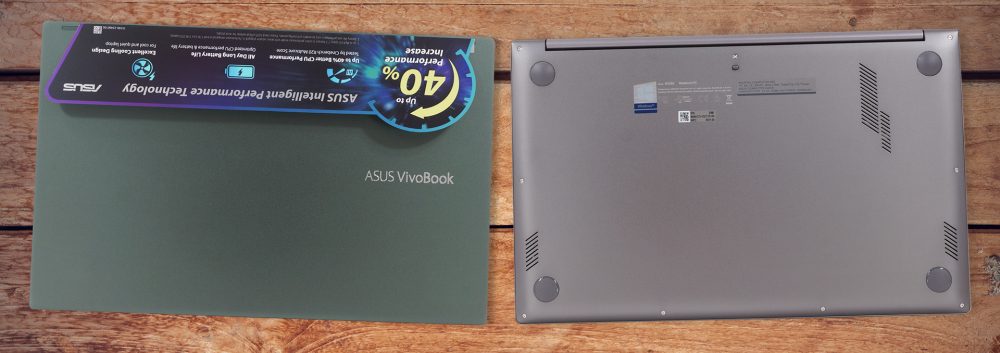


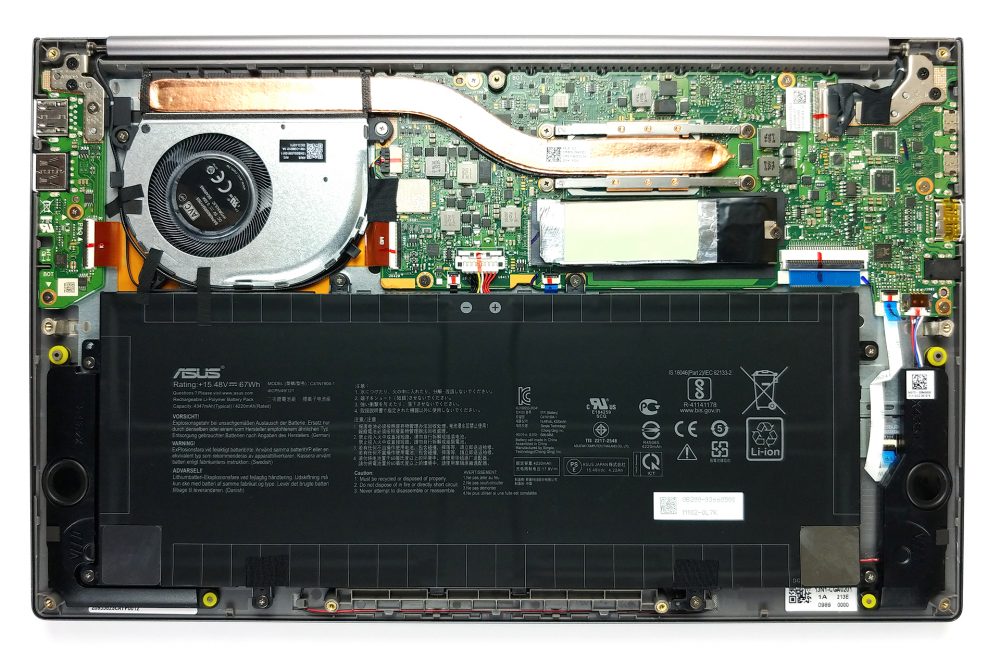
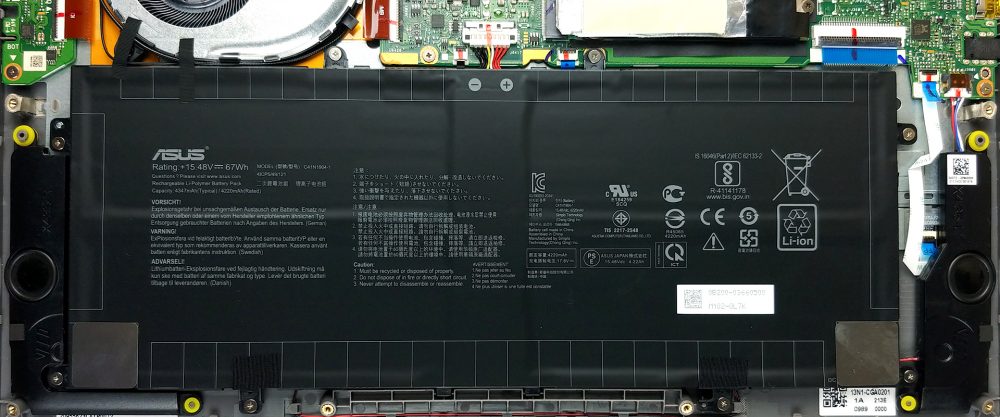
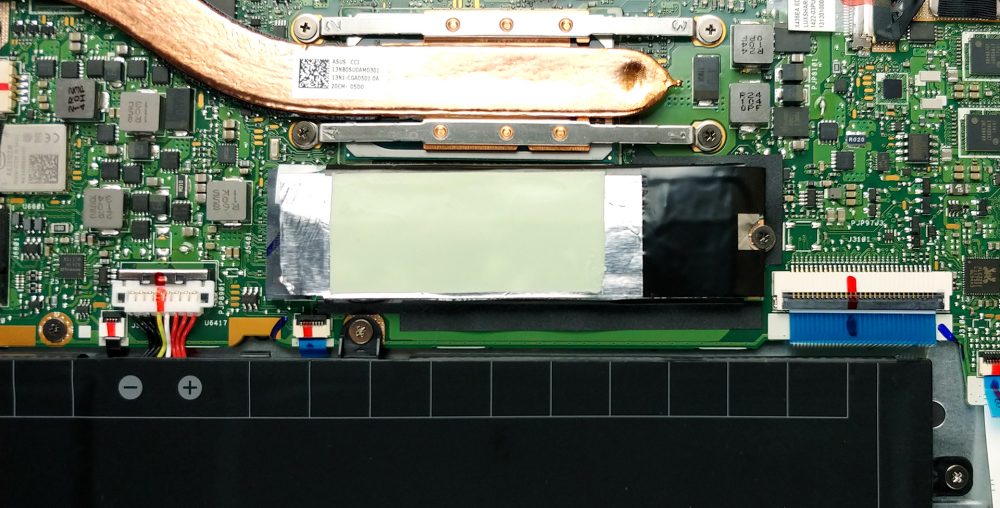

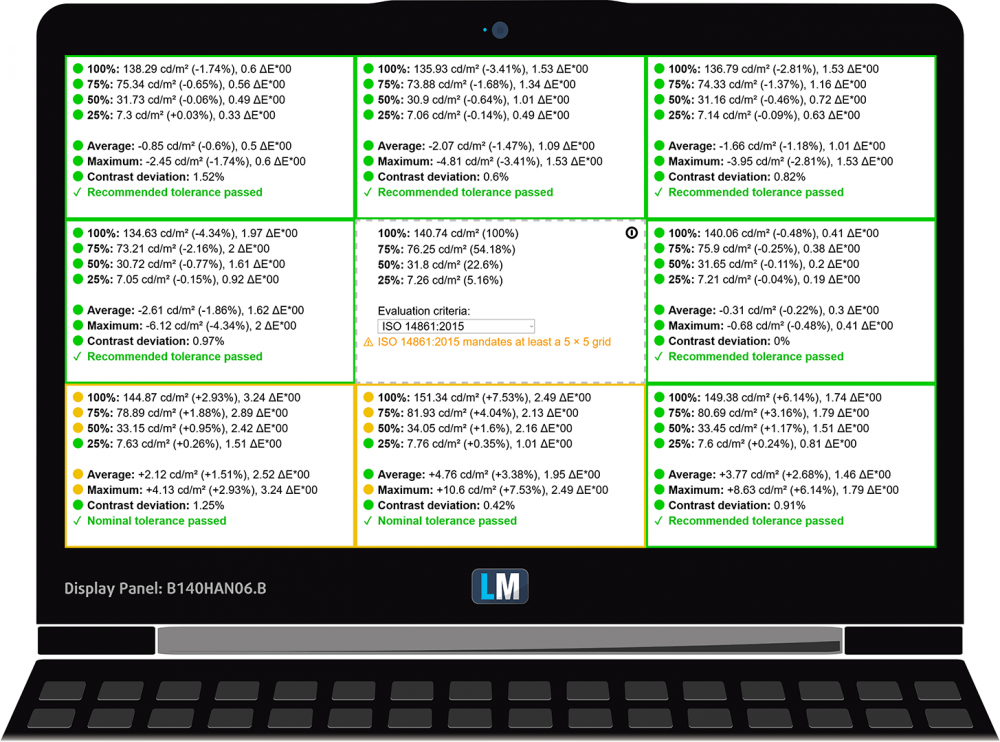
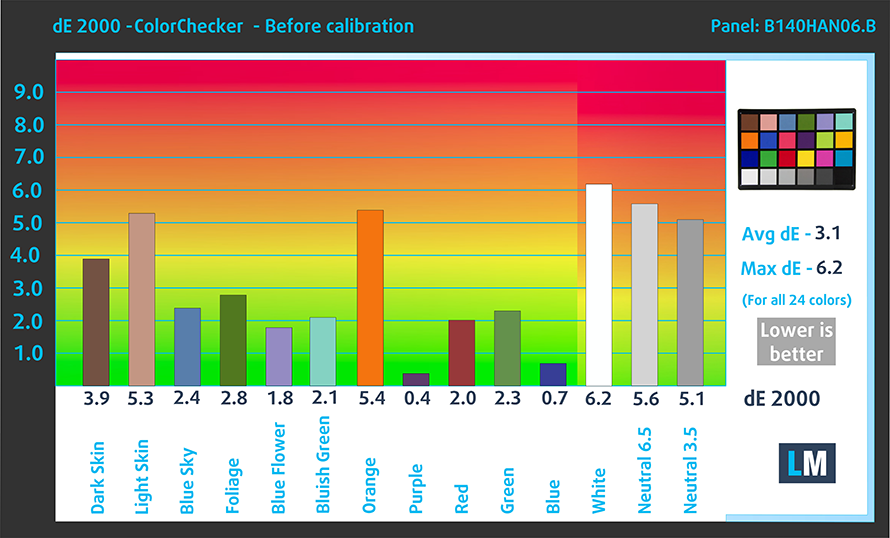
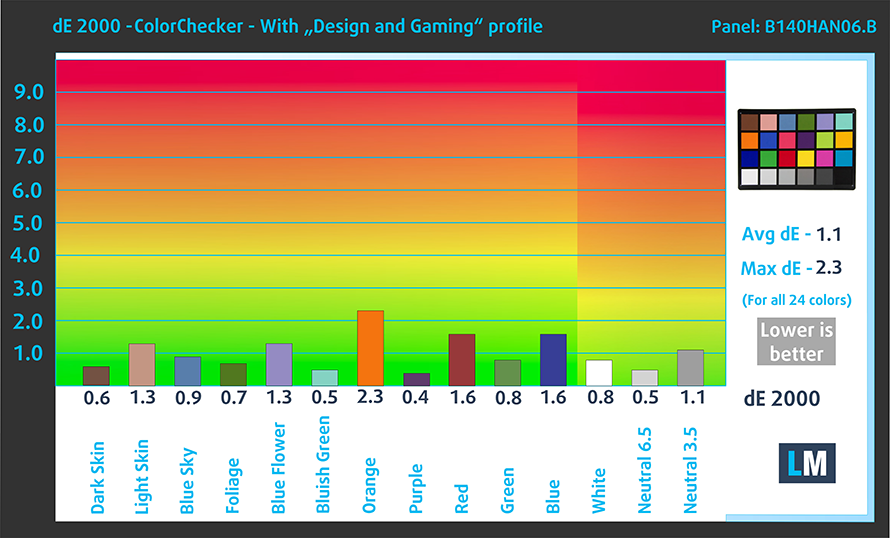

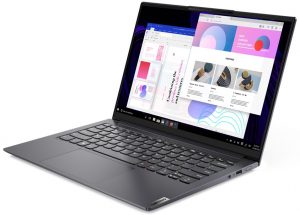










You guys review so many of these laptops? Will you make it a point to mention specifically which of these laptops support Modern Standby?
Hello! Is the any significant difference between the ASUS VivoBook S14 M433’s Harman Kardon speakers and the S14 S435 speakers?
I have this model Laptop ASUS VivoBook S14 S435EA-KC046, Intel Core i5-1135G7, 14inch, RAM 8GB, SSD 512GB, Intel Iris Xe Graphics, No OS, Deep Green I bought this model in May in Romania at the price of 570 euros, definitely a best buy at that price, very satisfied with the purchase, bright screen, high autonomy, good performance, the only defect would be the ram memory being welded on the motherboard .